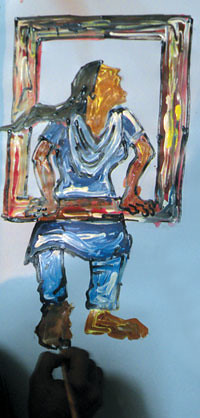 ANUPAM ROY |
In May 2005, six-year-old Anuska was abducted from a playground near her house in Sinamangal in Kathmandu. Few days later her decayed body was found in a neighbour's house. The little girl had been raped, tortured, and murdered.
Anuska's parents fought hard to put the suspect behind bars, but could not bear to see the culprit released after a week or so behind bars. Within a year of the crime, they had left the country for good.
Since November, while activists were marking the International Day for the Elimination of Violence Against Women, not a week has gone by without media reports of more atrocities. The crimes make a mockery of the government's avowed commitment to protect its citizens and expose a rot that has seeped deep into our patriarchal society.
Something is different this time. The murder of domestic worker Saraswati Subedi in the heart of the capital three weeks ago, the rape of a returning migrant worker by a policeman after robbing her of hard earnings at Kathmandu airport, and the two separate so-called 'honour killings' in Bara and Banke of young women who were burnt alive allegedly by family members galvanised media attention because of the sheer brutality of the crimes.
Perhaps inspired by similar protests in Delhi, rights and gender activists and ordinary citizens have taken to the streets outside the prime minister's residence and office demanding justice.
At the forefront of the demonstrations are the families of the victims, students, and common folks disgusted by the state's lack of interest in prosecuting the guilty. Despite what cynics say, these are spontaneous and largely independent protests, and as such there is a whole spectrum of demands. While some just want immediate action on recent rapes or murders, others have demanded the resignation of the home minister and even the prime minister. Some activists want better security for women, while others press for longer-term structural changes and enactment of laws equalising gender rights that were pending in the last parliament.
Whatever the demand, they all boil down to addressing existing male-centric legal and social arrangements that tolerate, embolden, and even protect those who perpetrate violence against women. The patriarchal values are so deep rooted that they manifest themselves within families, in the community, and the nation as a whole.
While the protests get louder outside the walls of the seat of political power in Kathmandu where celebrities amplify the slogans, there have been no such sustained protests in the districts of the eastern and western Tarai where rape and murder of women have taken epidemic proportions as we reported in this paper last month.
Until the citizen's movements against gender-based crimes reach a critical mass and the government's response goes beyond verbal assurances and political fire-fighting, the current movement will lack both the critical mass and staying power. The root reasons for gender violence lie in the organic linkages between culturally nurtured psycho-social behaviour and the tolerance of these crimes by state and society.
They also show a glaring failure of Nepali social science academia to investigate the larger socio-political context of gender violence in this country. Which is why gender activists are still preoccupied with a political battle for representation, while the global debate has moved on to the third wave.
After a week of sit-ins and stand-outs, the government has agreed to probe recent cases and promised new directives within a month. But there is no word on the hundreds of pending rape cases in courts across the country, including those from the years of conflict involving high ranking security officials.
The occupiers of Baluwatar are getting the headlines, but if these larger issues are not followed through, there is a danger the movement will ultimately fizzle out despite all attempts to breathe life into it through social media.
Read also:
We shall overcome, RUBEENA D SHRESTHA
At 12, she lost her innocence and was made to feel ashamed for something that was not her fault
See:
Al Jazeera video on
Rallies against rape in Nepal



